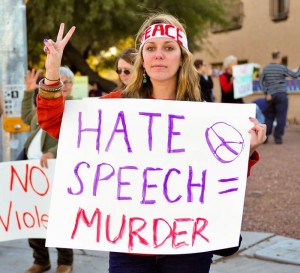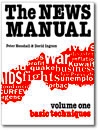DogBitesMan » General, Journalism, Media, Society » One man’s meat …
One man’s meat …
 It’s all very well – and probably necessary – to expect the peddlers of hate to bear some responsibility for Saturday’s multiple murders in Pima, Arizona, if only because of the atmosphere of hatred their rantings helped to create.
It’s all very well – and probably necessary – to expect the peddlers of hate to bear some responsibility for Saturday’s multiple murders in Pima, Arizona, if only because of the atmosphere of hatred their rantings helped to create.
It is too early yet to say what drove 22-year-old Jared Lee Loughner to kill or wound 20 people, including a US Congresswoman, a Federal Court judge and a nine-year-old girl. Was it partly the crass ravings of shock jocks like Rush Limbaugh or the shallow showboating of politicians such as Sarah Palin? Sheriff Clarence Dupnik suspected as much.
Certainly the killer seemed to have publicly espoused right-wing, anti-government views, but these are opinions shared by millions of concerned, law-abiding US citizens so we will have to wait to see whether his shooting rampage was sparked by specific urgings to rid public life of liberals such as Congresswoman Gabrielle Giffords or by some as-yet-unexplained impulses of a troubled mind.
Americans are currently conducting a lively and typically partisan debate about the issue of responsibility, and seven days after the killings a Google search of all the relevant keywords combined already produces more than two-million Internet references.
The blogosphere, online forums and the media are full of opinions accusing or excusing the commentators and politicians most likely to have prompted the killings – if, in fact, this happened – but perhaps we in the media should pause to consider how much we are to blame, if not for whipping up hatred in this particular case then at least for consciously or unconsciously aiding and abetting those in society who do.
It’s one of the great perennial conundrums of journalism: “How responsible are we, as journalists, for the negative effects of the things we report?”
Out this core question spring others, such as: “If we are even partly to blame, should we and could we do anything about it?”
News is often a self-fulfilling prophesy.
If news is defined as what is new, unusual and interesting or significant, then anything can be made into news, any event can be reported in such a way as to fulfil the criteria.
What we call “sensationalising” is just one end of the news construction spectrum, the end where we perhaps go too far in hyping up the immediacy or the novelty of an event or an utterance. But much of the work of journalists, the everyday spadework, goes into making the ordinary into news.
It’s an old joke in journalism “Isn’t it amazing there’s always just enough news to fill the newspaper (or bulletin)?”
Young journalists are taught to both seek out news but also to recognise otherwise unpromising events for their potential newsworthiness. We do it every day. Even a simple thing like an interview with a bishop can be turned into news if the journalist can get him or her to admit to doubts about their faith.
It’s as if a light goes on in our head – and we’ve all experienced it – the moment we spot the opportunity, when we seamlessly create the headline for the paper or bulletin: “Bishop admits to shaky faith in God.” Gotcha! Not the bishop – who is actually just collateral damage from that point on – but we nailed the story.
Every minute of every day journalists throughout the world are labouring in the manufacture of news by turning base ore into nuggets of gold.
This is not – or should not be – trickery or some strange alchemy. Few journalists worth the name will conjure news from nothing; that would be lying. But most journalists have created something newsworthy out of very little. There would not be many journalists who have not, at some point in their career, made news from a relative non-event, few photojournalists or cameraman who haven’t, by careful framing or perspective, made a drama more dramatic, a crowd bigger – or smaller – depending on the demands of the news angle they’re illustrating.
When I first started out in journalism as a young reporter on my hometown newspaper, one of the most feared jobs for trainees[i] was “the country run”. Though the paper, the Grimsby Evening Telegraph, was based in a mid-sized northern English port, a large number of its readers either lived in the surrounding rural Lincolnshire or had drifted in from its villages and farms. In the silly season or on days when real newsworthy events were scarce, rather than have relatively useless reporters sitting round rewriting press releases, the news editor would send one of us out with a photographer on “the country round”.
“And don’t come back without three stories,” he’d yell at our departing backs. “Minimum!”
If we were lucky, we’d get one of the older, more experienced photographers who’d know someone who might have a story. Or they might have seen something last time they were out that was worth following up. Or, most common, they’d heard something interesting, some tip worth following, in a pub over a ploughman’s lunch.
And we never failed to come up with the goods. Though we might spend all day driving from one part of the county to another, we’d return with my notebook full and an exposed roll of film ready for some clever semantics at the Remington or some crafty nip-and-tuck work in the darkroom. Always.
We justified it then – and I kind of justify it now – by saying we were telling “real stories about real people”, fulfilling our role as a cornerstone of the community.
It became harder over the years as I moved up and out of rural Lincolnshire to justify why I described a child whose throat had been slashed with a knife – and lived – as having had “his head almost severed from his shoulders”, but somehow we all managed to live with it, to sell papers or radio airtime, to bring some drama into readers’ or listeners’ lives, to let them know they had not wasted their time by picking up the paper or tuning in the radio.
We had our Sarah Palins in those days too and we were never a million miles away from a Rush Limbaugh or an Alan Jones or John Laws in Australia – though far enough to point out they were “commentators” and we were “journalists”.
But when we reported their outrageous claims or wild-eyed rants – turning them into “just enough news to fill the newspaper” – we were not very far at all.
Demagogues know the media’s weak spots and exploit them.
Rabble-rousers like Limbaugh say outrageous, nasty things about Democrats, women and African-Americans partly because they believe them, largely because they get their kicks from upsetting people – getting a response demonstrates they are somebody in an otherwise empty world – and mainly because they know that if they were more moderate the media would pay them less attention.
In this they are like an SBS TV journalist I once heard tell an audience: “First I get people’s attention, then I decide what to say.” Honestly.
It really doesn’t matter what Limbaugh and his cohort say as long as it is outrageous, hurtful and grabs the headlines. He doesn’t even need to be ultra-conservative, Fascist or a neocon, though it helps to be right wing because liberals, in general, are philosophically opposed to such cruel and juvenile behaviour; they will always fight with one hand tied behind their backs.
If one wanted further proof that Limbaugh is as dumb as a donkey, one need only read his comments after the Pima shooting when he blamed the Democrats, of all people, for the tragedy.
But it doesn’t matter to many journalists whether he’s a few clowns short of a circus. Indeed, it helps us write our copy or get our soundbites precisely because we don’t need to present a lengthy rational argument with such people. Emotiveness is everything.
When Australian shock jock Alan Jones used the airwaves of Radio 2GB to stoke the fires of hatred during racist riots in Cronulla in December 2005, he made more headlines and occupied more broadcast hours than anyone urging sanity and restraint. The fact that he was widely condemned only confirmed in his own mind that he was on a crusade and that “they” were ganging up against him, whoever “they” were. In a few short days he went from bully to martyr.
So where does that leave journalists? We’re damned if we report mindless demagoguery and damned if we don’t.
The difference is that in the former we are doing our job, in the latter we are doing our duty.
[i] We were called “apprentices” in those long-vanished days.
Filed under: General, Journalism, Media, Society · Tags: Alan Jones, Clarence Dupnik, Cronulla riots, definition of news, Gabrielle Giffords, Grimsby Evening Telegraph, Jared Lee Loughner, John Laws, making news, mass shooting, news, newsworthy, photojournalist, Pima, Radio 2GB, Rush Limbaugh, Sarah Palin, sensational, shock jocks













